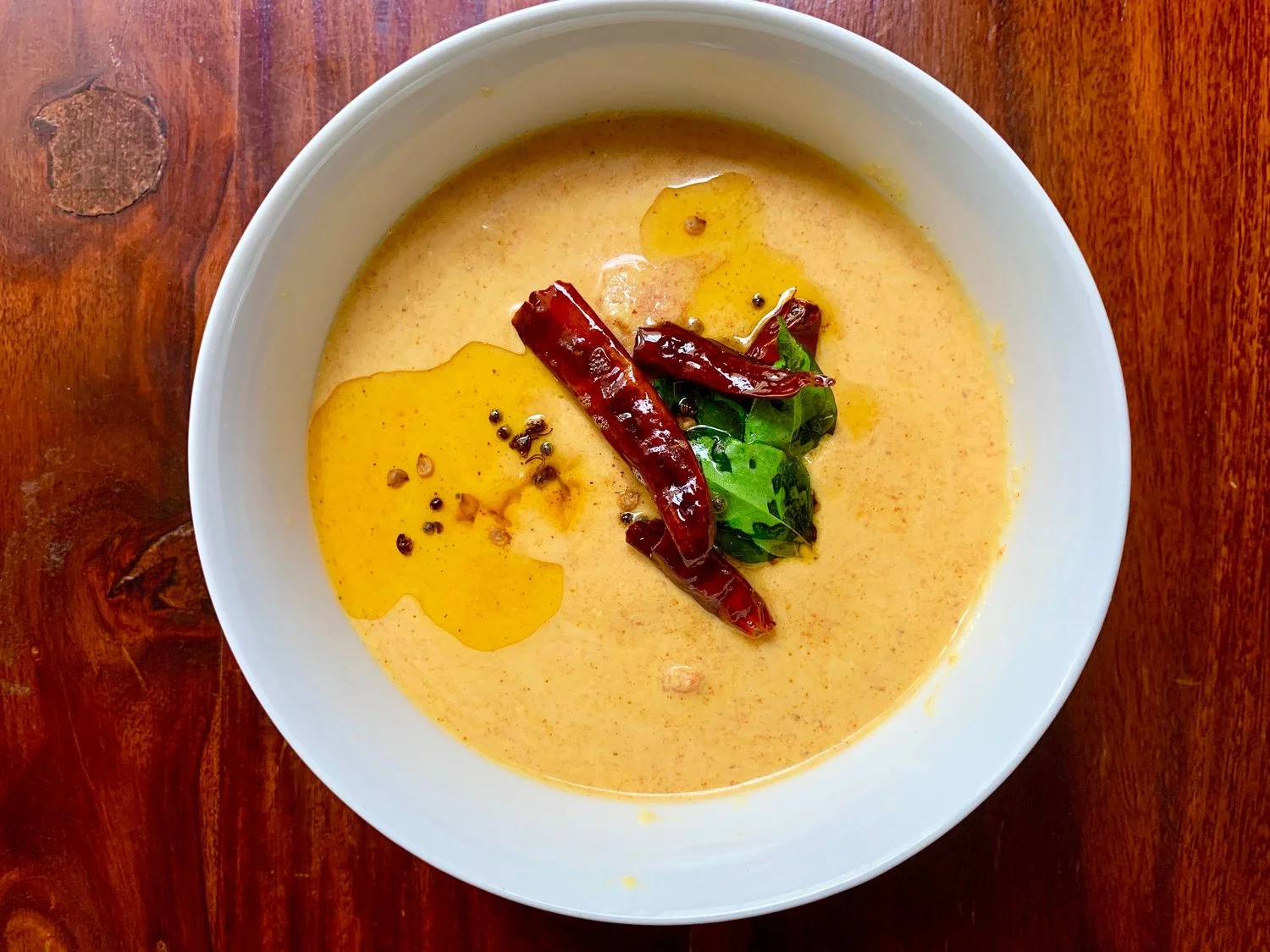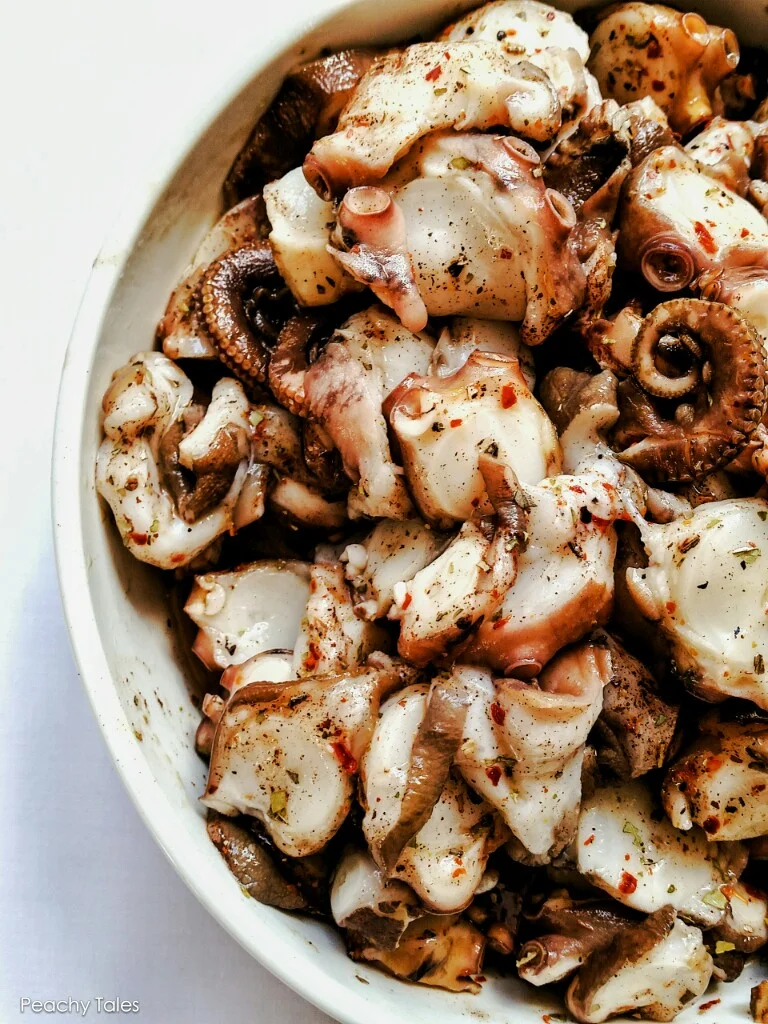A Brief History of the Mighty Mustard (Plus A Recipe for Octopus Vindaye)

Meha Desai traces the fascinating history of mustard, from the ancient Greeks and Romans, to modern French and American cuisine, all the way to the beloved Mauritian dish, vindaye, pickled octopus with mustard.
“Almost anything is edible with a dab of French mustard on it.” Or so Nigel Slater would have us believe. Some dishes are unimaginable without mustard: a spoonful of Dijon to brighten salad dressing, in the French countryside; rasping mustard seeds in a Kerala curry; a generous squeeze over a hotdog, in the streets of New York; a honey-mustard dipping sauce with fried chicken in the American South; an apple-mustard barbeque sauce anywhere with a good spit; or shorshe ilish in a Bengali kitchen. There is no denying that the human obsession with mustard runs deep.
As a condiment, mustard is ancient. As a cultivated plant, it is older still. Although some varieties of mustard plants were farmed crops in Hellenistic and Roman times, historians tell us that there are almost no archeological records available for any of them. Wild forms of mustard and its relatives — the radish and turnip — have been found all across West Asia and Europe, suggesting their domestication occurred somewhere in that region. The Encyclopædia Britannica states that mustard was grown by the Indus Valley Civilisation between 2500–1700 BCE. Some say that ancient Egyptians tossed the black seeds onto their food, and sent King Tut to the great beyond with an ample supply in his tomb. Other evidence suggests the Sumerians ground it into a paste and mixed it with verjus, the juice of unripe grapes. According to the Saskatchewan Mustard Development Commission, some of the earliest known documentation of mustard dates back to Sumerian and Sanskrit texts from 3000 BCE. Yet, it’s exact origins remain elusive.
A Kerala pachadi tempered with mustard
When it comes to prepared mustard, we have better luck. Almost everyone, scholars and gluttons alike, agree that prepared mustard dates back thousands of years to the early Romans, who ground it and mixed it with wine at the table itself. Long before the advent of the Asian spice trade, and the Western love affair with pepper, which originated in India, mustard had established itself firmly in the European psyche. Once trade routes were established, ancient people from India to Egypt to Rome devoured mustard seeds with their meat for seasoning. A recipe for mustard appears in De re coquinaria, the anonymously compiled Roman cookbook from the late fourth or early fifth century BCE. A famously long ingredient list for spit-roasted boar includes ground mustard alongside pepper, caraway, lovage, grilled coriander seeds, dill, celery, thyme, oregano, onion, honey, vinegar, fish sauce, and oil.
The Romans eventually took the mustard seed to Gaul, where it was planted in vineyards alongside the grapes. Eventually, French monasteries got involved as they did in those days, and by the 10th century, the monks of Saint-Germain-des-Prés in Paris had absorbed the mustard-making knowledge of the Romans and begun their own production. The first appearance of mustard makers on the royal registers in Paris dates back to circa 1292. Dijon, France, became a recognised centre for mustard making by the 13th century. There is no doubt about the popularity of mustard in Dijon: written records tell us tales of guests consuming as much as 320 litres of mustard creme in a single sitting at a gala held by the Duke of Burgundy in 1336. By the 1400s, King Louis XI refused to travel without his personal mustard maker, and always kept a pot of his favourite mustard with him so that he would never have to, god forbid, eat inferior mustard.
Joan Roca’s steak tartare with mustard ice cream
Today, chefs around the world breathe new life into an ancient favourite: In Gerona, Spain, Joan Roca serves his steak tartare with a mustard ice cream. Across the Atlantic, in New York, pastry chef Stephanie Prida is redefining desserts with her mustard, chocolate, figs, and tomato-honey ice cream plate. In Detroit, bartender Joe Robinson is nitro-muddling mustard greens in his cocktails. His Club Yellow cocktail is a savoury-sweet balance comprised of prepared yellow mustard, bourbon, milk syrup, honey liqueur, and black truffle salt.
And yet, it is in the simplest form that mustard seeds and greens shine brightest: an easy Chinese hot mustard sauce served alongside sweet duck sauce with fried noodles as appetizer; piping hot sarson ka saag with makai ki roti and white butter; a generous helping of English mustard across a thick-cut slice of white bread with ham (a Marco Pierre White approved combination); a rai ka tadka in lassi. Or the lesser known but equally enchanting Mauritian vindaye.
An Indian Ocean island, first discovered by the Moors, Mauritius has a labyrinthine history. Dina Arobi or the Isle of Desolation was discovered and abandoned by the Arabs as early as the 10th century. In the early 16th century, the first Europeans, the Portuguese, arrived. They, too, were more interested in trade and never settled here. By the late 16th century, the Dutch had landed on the island. And even though they deserted it by 1710, they left their mark: in the short time they were here, the Dutch were responsible for the extinction of the dodo and for introducing slaves from Africa, deer from Java, wild boar, tobacco and, above all, sugarcane. Soon after they left, the French arrived. Under their rule, Ile de France, grew into a thriving seaport, known for its sugar plantations. By the 19th century, the British, who dreamt of supremacy in the Indian Ocean, were fighting the French for the island. Eventually, they won and renamed the island Mauritius, but allowed the Franco-Mauritians to keep their language, religion, legal system, and most importantly, the sugarcane plantations on which the economy depended.
With the abolition of slavery in 1835, indentured labour began with Chinese, Malay, African, and Malagasy labourers, but ultimately, it was India that supplied the much needed labour for Mauritius. As many as 500,000 coolies (the derogatory term used back in the day) took up the promise of a better life in Mauritius, often to find themselves living and working in appalling conditions on minimum pay. A second wave of immigration brought Chinese merchants to the island. Today, Chinese, Creole, European, and Indian influences blend effortlessly to create a stunning local cuisine.The Dutch brought some of the main ingredients to the island chief amongst them cerf or deer, the French taught the Mauritans how to daube and civet (or stew) everything and also imparted their love of bread. One of the most indulgent street foods even today is an achards legumes, a wonderful pickle of fresh vegetable drenched in a mustard sauce that would make the Romans proud, sandwiched in a fresh round loaf of pain maison. The Chinese gave the local cuisine its love for sauces of all kinds, mien frites (fried noodles), and bol renverse, a delectable hot-pot of myriad ingredients, the quintessential culinary coddling in a bowl. The Indians, amongst many things, brought their cari (curry of course), biryani (known locally as briani), lenti or lentils, and of course the beginnings of what would ultimately become the Mauritian vindaye.
An uncomplicated pickled octopus or fish, some people trace the origins of vindaye to a Portuguese dish called vinha-d’alho (meat marinated in wine with herbs, spices, and of course a good dose of garlic), better known to us as the infamous vindaloo from the West coast of India. Legend has it that Indians who came with the British as indentured labourers in the nineteenth century brought the dish with them and eventually, the name was Frenchified to vin d’ail, which literally means ‘wine with garlic’. Though the earliest known recipes of vindaye make no mention of mustard, no self respecting Mauritian today would make it without a handful of mustard seeds thrown in. Garlic, onions, green chiles, vinegar and the beloved mustard seeds come together to pickle your choice of protein: octopus is a favourite, but you can’t go wrong with any firm white fish, chicken, or even bitter gourd. And even though the mustard seeds might seem like one of many components in a deceptively simple dish, they bring an undeniably distinctive depth of flavour that adds pungent heat as it hits the tongue, accentuates the sharpness of the vinegar in just the right way, and then ever so subtly, cooling the palette right at the end.
Whichever way you bite it, there is no denying the fact that the Mauritian vindaye is a must-try for any mustard aficionado. If you’re daring enough to order it with your chocolate and tomato-honey ice cream, or have it in your drink with bourbon and milk syrup, a pickled octopus sounds rather safe. (Though to ancient Romans, this would be nothing short of blasphemy.) But as every gastronome knows “good food and good eating is all about risk.” As Anthony Bourdain said, “Whether we're talking about unpasteurised Stilton, raw oysters or working for organised crime associates, food... has always been an adventure.”
Image credit: Peachy Tales
Recipe for Vindaye Ourite
Ingredients
1.5 kg octopus
3 medium onions, sliced
10 small green chilies, sliced
4 gloves garlic
2 tbsp garlic paste
2 tbsp freshly ground mustard seeds
1 tbsp turmeric powder
1/2 cup flour
4 tablespoons white vinegar
4 tablespoons oil
Salt to taste
Pepper to taste
Method
Clean the octopus and remove the ink bag.
Rub the octopus with flour and wash thoroughly.
In a large skillet, add garlic. Sautee for a minute, then add the octopus.
Cover and cook on medium heat until the octopus turns to a light pink colour and is completely soft.
Now, remove the octopus, allow to cool and cut into bite sized portions.
Marinate the onion in vinegar for 15 minutes.
On low heat, warm oil in a pan. Add the turmeric powder, ground mustard seeds, and garlic paste and keep stirring.
Turn off the heat and add the octopus to the spices.
Add the onions and the sliced chilies and mix well.
Add salt and pepper to taste. Allow to cool and serve.
Vindaye Ourite can be stored in a jar in the fridge for later use.
Banner image courtesy Get Local Africa.
Meha Desai is a freelance writer based out of Mauritius. She runs Heritage Foodways, an independent research organisation that documents disappearing culinary traditions around the world.
ALSO ON THE GOYA JOURNAL











